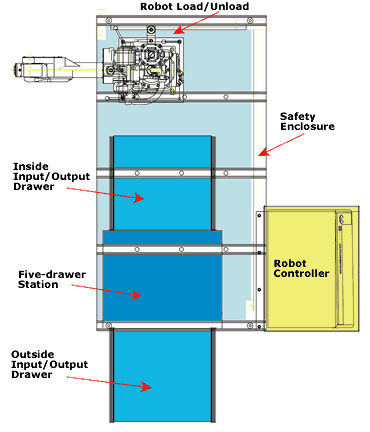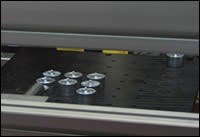Simplifying Machine Load/Unload Automation
Today, lower part volumes and frequent change-over are changing the offerings of some automation integrators. Standard, off-the-shelf components are being engineered to work together in a large variety of applications and, in some cases, are even portable so they can be moved from machine tool to machine tool.
Increasingly, shops are looking for ways to automate their production capability. In many cases, the object is to help lower costs by allowing untended or lightly tended operation. Automating the materials handling, post-process gaging, deburring and other operations goes a long way toward the automation goal. Historically, the integrators that offered these automation solutions were “custom” houses. They built a system that was fairly specific to the application. That was when production runs justified a “harder” automation. Today, lower part volumes and frequent change-over are changing the offerings of some automation integrators. Standard, off-the-shelf components are being engineered to work together in a large variety of applications and, in some cases, are even portable so they can be moved from machine tool to machine tool.
One robotic systems integrator that has moved toward producing standard automation is Automated Concepts, Inc. (Council Bluffs, Iowa). At IMTS 2006, it introduced the lean machine unload/load cells. The lean system was developed to provide potential automation users with an economical and low-risk means for bringing automation into their facility. Although ideally suited for handling small parts in any small and medium-sized job shop, the system is useful for any size company looking to have a portable automation system.
Significantly less expensive than custom systems, the lean standard system is ready to pull from stock and ship with no engineering required for the base system, providing a lower capital investment and higher ROI than custom systems, according to the manufacturer. Installing pre-engineered systems also reduces the risk often associated with developing custom solutions.
Another advantage of the cell is its portability. Once installed, should the machine tool need to be reconfigured for a different part or require servicing, the entire cell can be picked up with a forklift and moved until the work is completed.
When designing the lean system, Automated Concepts, Inc. (ACI) combined three standard systems into one platform of products consisting of three standard styles and three Fanuc robot models for a total of nine automated solutions.
The drawer-style lean machine system, the first product in the standard cell, is well-suited for applications using pre-cut parts or blanks that need to be machined. This style can handle parts weighing as much as 12 pounds and features a bi-directional, five-drawer part feeder, a Fanuc robot, dual back-to-back grippers, safety fencing and platform with a quick-connect wiring system. The configuration of this style allows the operator manual access while the robot works from another drawer.
Another standard product in the lean system is the rotary stack-style lean machine for round parts that can be stacked in both the raw or machined version. This style features a six-position indexer with adjustable part sizes from 2 to 6 inches for stackable parts that weigh as much as 12 pounds. This cell also features a Fanuc robot, dual back-to-back grippers, blank aluminum fingers, safety fencing and platform with a quick connect wiring system.
The third standard style in the system, the bowl feeder style, is ideally suited for applications with a high volume of small parts or slugs that can’t be bar fed. This style accommodates parts as much as 1 pound with a bowl feeder part size of as much as 2 inches in diameter (with some customization). This system, like the others, features a Fanuc robot, dual back-to-back grippers, blank aluminum fingers, safety fencing and a platform with a quick connect wiring system.
Automated machine load/unload systems provide users with benefits including higher throughput, improved process flow (because of predictable cycle times), reduced product damage (because of controlled handling) and consistent run speeds with no breaks, shift changes or rehires. In addition, when compared to an integrated gantry product, ACI says its lean machine cells provide better delivery and flexibility and are retrofitable, redeployable and easily relocated for future expansion of the process. Flexibility and future expansion are especially important since many gantry products are dedicated to a specific machine process, such as a lathe, and to convert them to work with a machining center can be costly and difficult to accomplish. However, change-over and future expansion is not a concern with the lean machine system, as it can be picked up by a forklift and moved to another location. It also can be set up and working in a short time.
All ACI cells can be retrofitted to existing equipment, but require machine tool options such as robotic interface, auto door, spindle orientation and air blow to support automation.
Taking advantage of a standard automation system, such as a lean machine unload/load cell, versus a custom system, not only offers a shop portability and flexibility, but also the convenience and lower capital investment of off-the-shelf purchasing and higher ROI.
Related Content
Automation in the Alps: Studer AG Unveils New Grinding Concepts
Studer AG, member company of United Grinding, held its annual press conference at its Swiss Alps location earlier this month to announce its new automatic loaders to accompany its existing grinding machines as well as other offerings and automation features.
Read MoreReinventing the Wheel with Robot-Automated CNC Multitasking
One race team discovers how to efficiently manufacture a new wheel nut design for the next-generation NASCAR stock car with the help of a CNC mill/turn and a built-in robot.
Read MorePursuit of Parts Collector Spearheads New Enterprise
While searching for a small parts accumulator for Swiss-type lathes, this machine shop CEO not only found what he was looking for but also discovered how to become a distributor for the unique product.
Read MoreAutomation Idea for Halloween?
Maybe not. But, the candy-throwing robots at MetalQuest’s Nebraska facility do enable the contract machine shop to stand out at career fairs and similar events.
Read MoreRead Next
Gantry Takes Hands Out Of Part Handling
Automating material delivery and removal from the machining process is one key method of taking some of the production cost from manufacturing. Iemca, known for automating machine tools with its line of bar feeders, has introduced a new gantry system for chucked parts.
Read MoreDo You Have Single Points of Failure?
Plans need to be in place before a catastrophic event occurs.
Read MoreEmerging Leaders Nominations Now Open
Here’s your chance to highlight a young person in your manufacturing business who is on the path to be a future leader moving your company forward.
Read More












.jpg;maxWidth=300;quality=90)











